SAS Bundle
What Drives SAS: Mission, Vision, and Values?
Every successful company needs a strong foundation, and for SAS, that foundation is built on its mission, vision, and core values. These guiding principles shape the company's identity and drive its strategic direction in the competitive analytics software market. Understanding these elements is key to appreciating SAS's long-term goals and its approach to business.
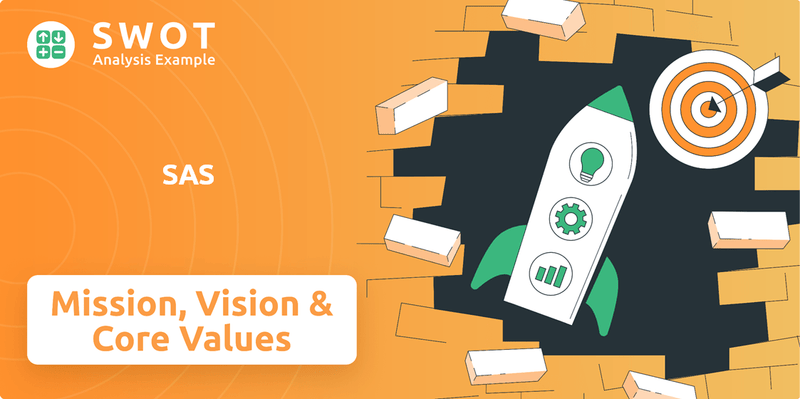
Delving into the SAS SWOT Analysis can further illuminate how these internal principles translate into external strategies and market positioning. This exploration of the SAS mission, vision, and core values offers valuable insights for investors, business strategists, and anyone interested in the SAS Institute's approach to innovation and sustained success. Examining the SAS company culture and values provides a deeper understanding of their impact on employees and overall business performance.
Key Takeaways
- SAS's mission focuses on delivering timely, valuable knowledge, emphasizing customer-centricity.
- The vision to be a trusted data and AI partner highlights SAS's leadership and reliability.
- Core values (Curious, Passionate, Authentic, Accountable) drive innovation and ethical practices.
- Alignment with these principles is crucial for SAS's continued success in the analytics market.
- Emphasis on ethical AI, data privacy, and sustainability will be key for future growth.
Mission: What is SAS Mission Statement?
SAS's mission is 'to provide knowledge in the moments that matter.'
Let's delve into the heart of SAS: its mission. The Competitors Landscape of SAS reveals a dynamic market, but SAS distinguishes itself through its unwavering commitment to its mission. This commitment shapes its strategy, influences its culture, and ultimately, drives its success.
The SAS mission is concise yet powerful. It emphasizes providing timely and relevant knowledge to empower organizations. This focus on actionable insights is a cornerstone of their business model.
SAS's mission is inherently customer-centric. Their target customers include organizations across various industries, all seeking to leverage data for improved performance. This focus ensures their solutions are aligned with customer needs.
The mission is outcome-oriented, emphasizing the value derived from using SAS technology. It's about transforming data into actionable insights that drive results, impacting key performance indicators (KPIs).
Consider SAS's impact in healthcare and life sciences. They help customers unlock insights from data, potentially improving health outcomes. In the public sector, they empower governments to use data and AI for better, faster public services. For example, SAS solutions are used by 99 of the top 100 companies on the Fortune Global 500 list.
The mission's emphasis on providing 'knowledge in the moments that matter' underscores the importance of timely and accurate analytics. In today's fast-paced business environment, this is critical for competitive advantage. The ability to make decisions quickly based on reliable data is paramount.
The SAS company mission is not just a statement; it's a guiding principle. It influences product development, customer service, and employee engagement. The SAS culture is built around this mission, fostering innovation and collaboration. SAS invests approximately 24% of its revenue back into R&D, a testament to its commitment to its mission.
The SAS mission statement is a clear articulation of what the SAS Institute strives to achieve. It's about more than just selling software; it's about empowering organizations to make better decisions, solve complex problems, and ultimately, create a better world. Understanding the SAS mission is key to understanding the company's long-term vision and its commitment to its SAS core values.
SAS SWOT Analysis
- Complete SWOT Breakdown
- Fully Customizable
- Editable in Excel & Word
- Professional Formatting
- Investor-Ready Format
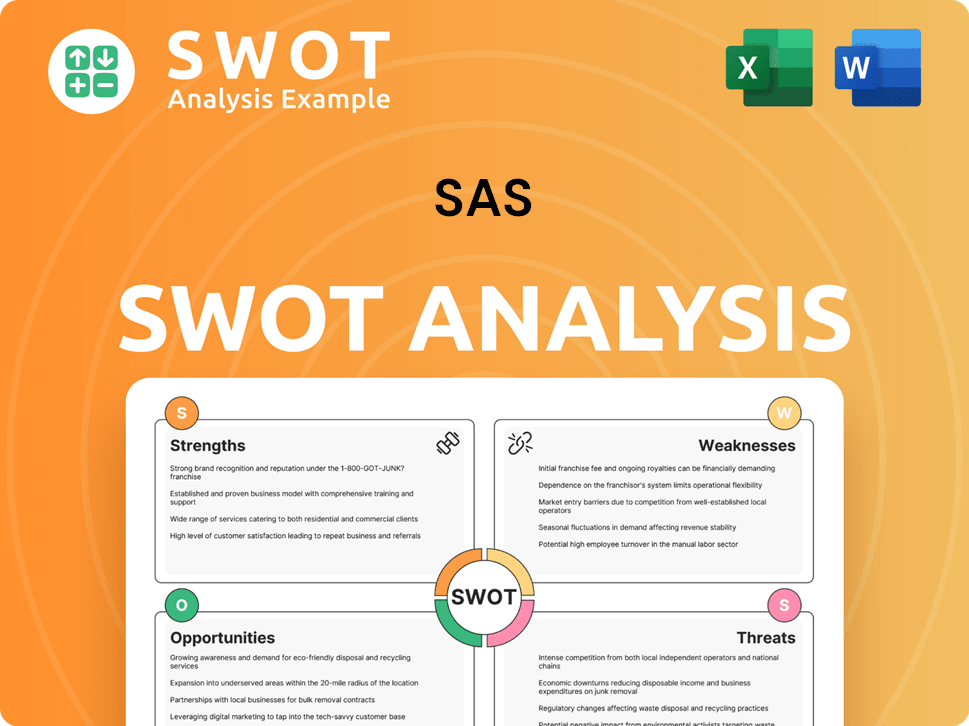
Vision: What is SAS Vision Statement?
SAS's vision is 'To be the most trustworthy data and AI partner that powers the world's decisions.'
SAS, formally known as SAS Institute, has a forward-thinking vision that underscores its commitment to shaping the future of data and artificial intelligence. The Target Market of SAS is broad, and its vision reflects this, aiming to be a global leader in its field. This vision is not just about technological advancement; it's also about building trust and enabling better decision-making worldwide. It's a bold statement that highlights SAS's ambition to be at the forefront of the data revolution.
The SAS vision statement is distinctly future-oriented, looking ahead to the evolving landscape of data and AI. It's about anticipating future needs and positioning the SAS company as a key player in addressing them. This proactive stance allows SAS to stay ahead of the curve and continue innovating.
In an era where data privacy and ethical AI are paramount, SAS's vision emphasizes trustworthiness. This focus is crucial for maintaining customer confidence and ensuring responsible use of AI technologies. SAS understands that trust is a key component of long-term success in the data and AI market.
SAS's vision has a broad scope, aiming for global impact by powering decisions worldwide. This expansive outlook reflects SAS's ambition to influence decision-making across various industries and geographies. SAS wants to be a global force in the data and AI space.
Given SAS Institute's established leadership in data and AI, and its continuous innovation, the vision is both aspirational and realistic. SAS has a proven track record of delivering cutting-edge solutions. SAS is well-positioned to achieve its vision.
SAS continuously invests in research and development, including advancements in AI and cloud expansion. This commitment to innovation is essential for realizing its vision. SAS is always evolving to meet the changing needs of its customers.
SAS's vision is centered around enabling better decisions through reliable data and AI. This focus on data-driven insights is crucial for helping organizations make informed choices. SAS is committed to empowering its customers with the tools they need to succeed.
The SAS vision is a comprehensive statement that reflects the company's ambition to be a leader in the data and AI industry. It emphasizes trust, global impact, and continuous innovation. The SAS mission and SAS core values work together with the vision to guide the company's actions and decisions. Understanding the SAS vision and values explained is key to appreciating the company's long-term goals. The SAS company culture and values support this vision by fostering a collaborative and innovative environment. The SAS mission vision and goals are all aligned to drive the company's success. The SAS leadership principles and SAS employee values are also integral to achieving this vision. The SAS company's mission and vision are designed to create a positive impact on the world. The examples of SAS core values in action demonstrate how the company lives up to its vision. The history of SAS mission and vision shows the evolution of the company's goals. The SAS values and its impact on employees is significant, as is how the SAS core values drive innovation. The SAS mission vision and core values for employees create a strong foundation for success. SAS's vision is a guiding light for its future endeavors.
SAS PESTLE Analysis
- Covers All 6 PESTLE Categories
- No Research Needed – Save Hours of Work
- Built by Experts, Trusted by Consultants
- Instant Download, Ready to Use
- 100% Editable, Fully Customizable
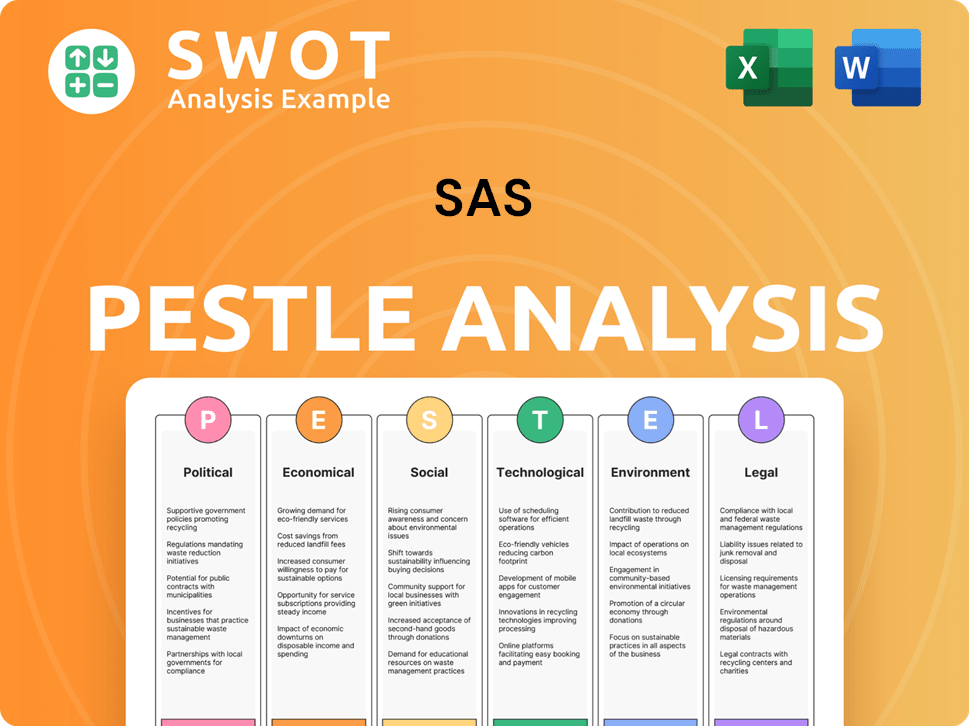
Values: What is SAS Core Values Statement?
Understanding the core values of SAS is crucial to grasping the essence of SAS Institute's operational philosophy and its approach to the data and analytics market. These values are not just words; they are the guiding principles that shape the company's culture, drive its innovation, and define its interactions with customers and partners.
Curiosity drives SAS to be relentless problem-solvers, constantly challenging assumptions and seeking new solutions. This value fuels SAS's significant investment in research and development, leading to innovative products like SAS Viya and advancements in AI, with R&D spending consistently over 20% of revenue. This commitment is evident in their continuous efforts to enhance their platform, with over 1,000 patents granted to SAS, showcasing their dedication to innovation.
SAS demonstrates passion through its dedication to excellence and a drive for meaningful contributions in all aspects of its operations. This is reflected in the high quality and reliability of its software, used by a significant portion of the Fortune 500, and their commitment to helping customers solve complex challenges. The company's focus on quality has resulted in high customer satisfaction, with a customer retention rate of over 90%.
Authenticity at SAS means being genuine, transparent, and leading with integrity, building trust with customers and partners. This value is crucial in the sensitive area of data and analytics, especially with the growing concerns around data privacy and ethical AI. This is reflected in their emphasis on trustworthy AI and data governance, which is key for their customers with data security and privacy regulations. SAS's commitment to ethical practices is a key differentiator in the industry.
Accountability at SAS means taking responsibility, doing things correctly, and exceeding expectations in delivering reliable software and services. This value is demonstrated in their efforts toward sustainability and corporate social responsibility. SAS's commitment to sustainability is evident in its LEED-certified headquarters and its various community outreach programs, reflecting a strong commitment to its impact on the world. This commitment to accountability is also a key factor in maintaining customer trust and loyalty.
These four core values – Curious, Passionate, Authentic, and Accountable – collectively define the unique SAS culture and its approach to business. They are fundamental to the company's success and contribute to its reputation as a trusted partner in the data and AI space. Understanding these values provides a deeper insight into the Revenue Streams & Business Model of SAS and its long-term strategy. Next, we'll explore how the SAS mission and vision influence the company's strategic decisions.
How Mission & Vision Influence SAS Business?
The SAS mission and SAS vision are not mere statements; they are the guiding principles that shape the company's strategic decisions and actions. These foundational elements influence everything from product development to market expansion, ensuring alignment across all facets of the business.
SAS's mission, "to provide knowledge in the moments that matter," directly influences its strategic focus on delivering actionable insights quickly. Their vision of being a trusted data and AI partner steers their investments in AI development and trustworthiness.
- Investment in AI and analytics: SAS's commitment to AI is evident in its expansion of SAS Viya, a cloud-native AI and analytics platform.
- Focus on specific industries: Targeting key vertical markets like financial services, healthcare, and the public sector allows SAS to address industry-specific challenges.
- Cloud partnerships: Collaborations with major cloud providers like Microsoft Azure, AWS, and Google Cloud Platform are crucial for providing flexible deployment options.
- Acquisition of Hazy: Enhancing synthetic data capabilities through the acquisition of Hazy supports their focus on innovation and trusted data.
The success of SAS Viya is a key indicator of the company's strategic alignment. In 2024, SAS Viya sales grew by 24%, and SAS Viya 4 sales increased by 56%. This growth demonstrates the effective execution of strategies driven by their cloud and platform modernization goals.
SAS Managed Cloud Services sales experienced a 16% increase in 2024, marking five consecutive years of double-digit cloud growth. This expansion reflects the company's commitment to providing cloud-based solutions that align with their mission and vision.
SAS leadership, including CEO Jim Goodnight, consistently emphasizes the importance of continuous innovation and addressing customer challenges. This commitment reinforces the company's dedication to its mission and vision.
SAS's strategic focus on key vertical markets, such as financial services, public sector, and health and life sciences, demonstrates a commitment to applying analytics expertise to solve specific industry challenges. This targeted approach directly supports their mission of providing knowledge in the moments that matter.
The partnerships with major cloud providers like Microsoft Azure, AWS, and Google Cloud Platform are driven by SAS's vision to be a global partner and their need to provide flexible cloud deployment options to meet customer needs. This strategy ensures accessibility and scalability for their solutions.
The acquisition of Hazy to enhance synthetic data capabilities aligns with SAS's focus on innovation and providing trusted data for AI model training. This strategic move supports their vision of being a trusted data and AI partner.
The SAS company's mission and vision statements are not static; they are dynamic forces that shape the SAS Institute's strategic direction. By understanding how these principles influence the company's decisions, we gain a deeper appreciation for its commitment to innovation and customer success. To further explore the strategies that support these goals, consider reading about the Marketing Strategy of SAS. Next, we will delve into the core improvements to the company's mission and vision.
SAS Business Model Canvas
- Complete 9-Block Business Model Canvas
- Effortlessly Communicate Your Business Strategy
- Investor-Ready BMC Format
- 100% Editable and Customizable
- Clear and Structured Layout
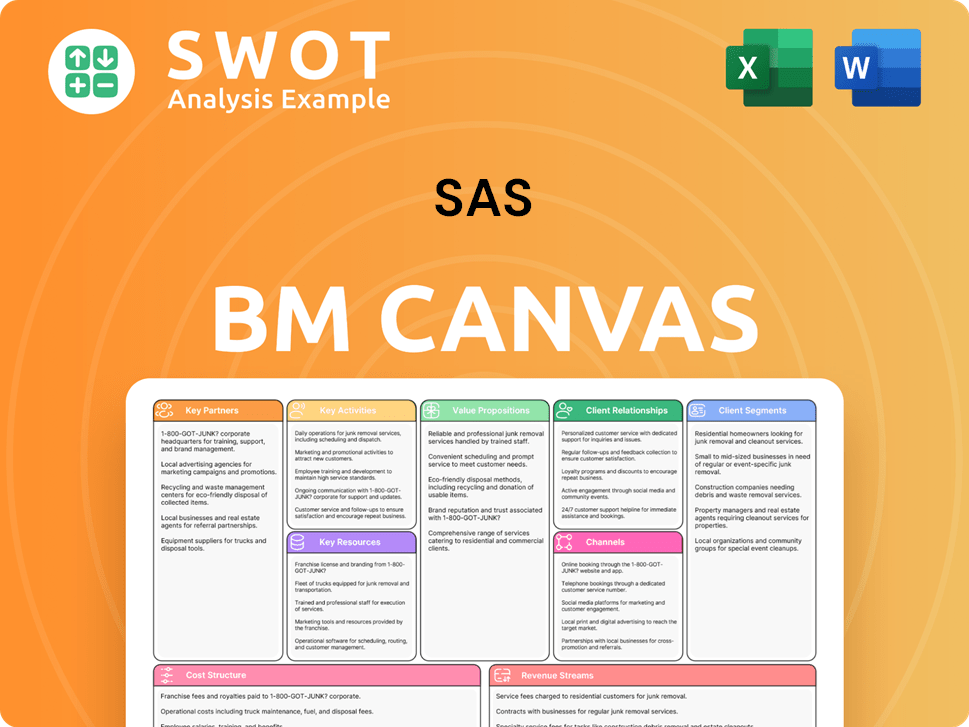
What Are Mission & Vision Improvements?
While the current statements of the SAS mission, SAS vision, and SAS core values provide a solid foundation, there's always room for enhancement in a dynamic market. These improvements can strengthen the company's position and better reflect its commitment to ethical practices and societal impact.
To address growing concerns about AI ethics, SAS could refine its vision statement to explicitly include ethical AI development and deployment. This might involve adding a phrase like "responsibly powering the world's decisions" to emphasize their commitment to ethical practices. This would align with the increasing market demand for responsible AI, as highlighted by a recent study indicating that 70% of consumers are more likely to trust companies that prioritize ethical AI practices.
SAS could refine its SAS mission to highlight the democratization of analytics and AI, reflecting its strategy to bring solutions to firms of all sizes. This could broaden the perceived scope of their impact beyond large enterprises, making it more appealing to a wider customer base. This is particularly relevant, as the global analytics market is projected to reach $274.3 billion by 2026, with significant growth in the small and medium-sized business (SMB) sector.
Given the increasing importance of data privacy and security, SAS could integrate a more direct link to data stewardship and privacy into its mission or vision. While their value of 'Authentic' touches on integrity, a more explicit focus on data privacy would resonate strongly with customers. The global data privacy market is expected to reach $13.3 billion by 2027, underscoring the significance of this area.
Although SAS has strong sustainability initiatives, explicitly weaving sustainability into their mission or vision could further solidify their commitment and appeal to environmentally conscious stakeholders. This would align with the growing trend of ESG (Environmental, Social, and Governance) investing, which saw record inflows in recent years. For more insights, explore Mission, Vision & Core Values of SAS.
How Does SAS Implement Corporate Strategy?
Implementing a company's mission, vision, and core values is crucial for translating strategic intent into tangible actions and outcomes. This section explores how SAS, also known as SAS Institute, demonstrates the practical application of its guiding principles across various aspects of its business.
SAS actively implements its Growth Strategy of SAS through strategic initiatives and product development. This commitment is evident in their continuous enhancement of the SAS Viya platform, directly reflecting their mission to provide knowledge and their vision to be a leading data and AI partner.
- SAS Viya Platform Development: Ongoing investment in SAS Viya, focusing on cloud-native capabilities, AI, and machine learning integration, exemplifies their commitment to their mission.
- Industry-Specific Solutions: The creation of solutions tailored for healthcare, life sciences, and other sectors demonstrates the practical application of their analytics expertise to address specific customer needs.
- Focus on Innovation: SAS invests heavily in R&D, with approximately 26% of its revenue allocated to research and development, ensuring they stay at the forefront of analytics.
- Global Presence: SAS operates globally, with a presence in 145 countries, enabling them to deliver their mission and vision to a broad customer base.
Leadership plays a vital role in embedding and reinforcing the SAS mission, vision, and core values. CEO Jim Goodnight's long-standing leadership and emphasis on innovation and corporate culture have been central to embedding the values within the organization.
The promotion of Gavin Day to COO, with a focus on guiding the company towards a potential IPO in 2025, suggests a strategic alignment with future growth and market positioning. This move is likely informed by their core principles and long-term vision.
SAS communicates its mission, vision, and core values through various channels to ensure understanding and alignment. This includes their official website, annual reports, and events like SAS Innovate, fostering a culture of transparency and shared purpose.
SAS demonstrates its commitment to its core values through tangible actions and programs. Participation in events like The Aviation Challenge showcases their commitment to sustainability, and their intern program highlights core values like authenticity and curiosity.
SAS Porter's Five Forces Analysis
- Covers All 5 Competitive Forces in Detail
- Structured for Consultants, Students, and Founders
- 100% Editable in Microsoft Word & Excel
- Instant Digital Download – Use Immediately
- Compatible with Mac & PC – Fully Unlocked
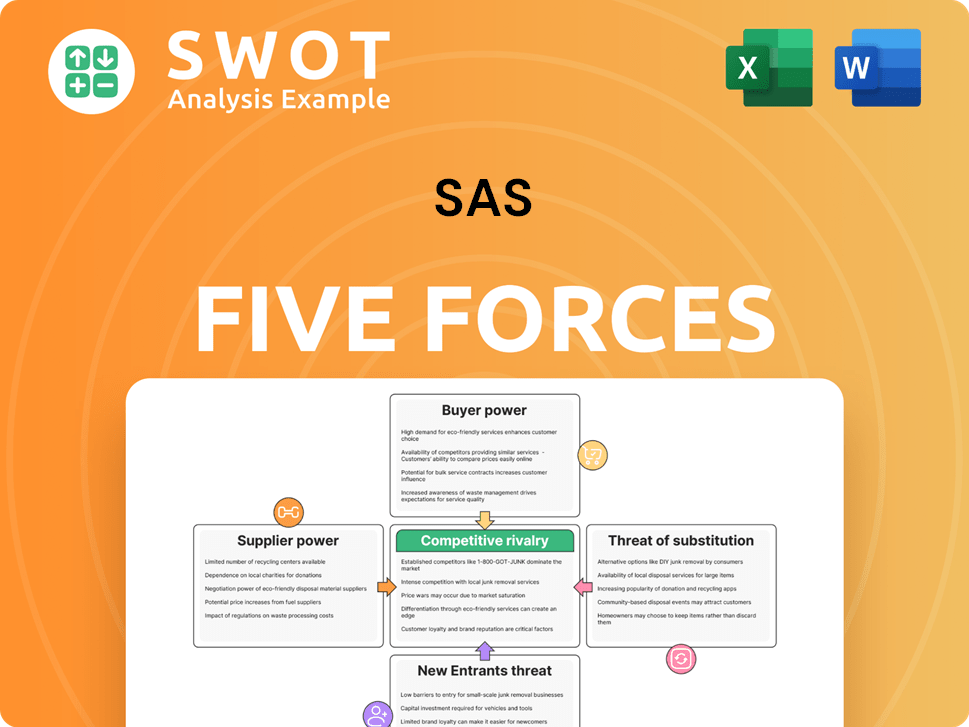
Related Blogs
- What are Mission Vision & Core Values of SAS Company?
- What is Competitive Landscape of SAS Company?
- What is Growth Strategy and Future Prospects of SAS Company?
- How Does SAS Company Work?
- What is Sales and Marketing Strategy of SAS Company?
- Who Owns SAS Company?
- What is Customer Demographics and Target Market of SAS Company?
Disclaimer
All information, articles, and product details provided on this website are for general informational and educational purposes only. We do not claim any ownership over, nor do we intend to infringe upon, any trademarks, copyrights, logos, brand names, or other intellectual property mentioned or depicted on this site. Such intellectual property remains the property of its respective owners, and any references here are made solely for identification or informational purposes, without implying any affiliation, endorsement, or partnership.
We make no representations or warranties, express or implied, regarding the accuracy, completeness, or suitability of any content or products presented. Nothing on this website should be construed as legal, tax, investment, financial, medical, or other professional advice. In addition, no part of this site—including articles or product references—constitutes a solicitation, recommendation, endorsement, advertisement, or offer to buy or sell any securities, franchises, or other financial instruments, particularly in jurisdictions where such activity would be unlawful.
All content is of a general nature and may not address the specific circumstances of any individual or entity. It is not a substitute for professional advice or services. Any actions you take based on the information provided here are strictly at your own risk. You accept full responsibility for any decisions or outcomes arising from your use of this website and agree to release us from any liability in connection with your use of, or reliance upon, the content or products found herein.